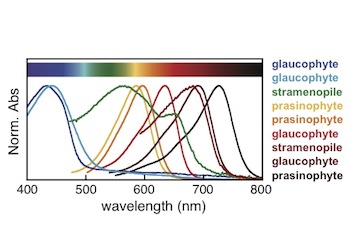Plants Detect Rainbow of Light, Bhattacharya Collaboration Finds
 An innovative study from the labs of Clark Lagarias at UC Davis, Alexandra Worden at the Monterrey Bay Aquarium Research Institute, and Debashish Bhattacharya reveals a rainbow of ways that algae can adapt to its environment.
An innovative study from the labs of Clark Lagarias at UC Davis, Alexandra Worden at the Monterrey Bay Aquarium Research Institute, and Debashish Bhattacharya reveals a rainbow of ways that algae can adapt to its environment.
The study, recently published in Proceedings of the National Academy of Sciences, looks at the diversity of light-sensing proteins, or phytochromes, in eukaryotic algae. Phytochromes responsive to red/far-red light enable land plants to respond to changing light conditions in their environments (such as shading by neighboring plants). Until Bhattacharya and his colleagues published this paper, "the world of phytochromes was thought to solely be limited to red-to-far-red sensing because only [land] plants or [algae without phytochromes] had been studied.”
In the ocean, though, the light that hits plants is different. First, plants below a couple of meters under the ocean surface don’t even receive the red to far-red light, because the water absorbs it. Second, the mixing of ocean water makes for more variable light conditions than on land.
So do oceanic plants with phytochromes, like algae, have a correspondingly diverse response to light? Worden's, Lagarias', and Bhattacharya's labs tested this by studying the light-sensing properties of synthetic phytochromes that they created from algal genetic data. The study revealed that "algae can sense a rainbow of wavelengths to adapt to their natural environments," says Bhattacharya. "It has become clear that phytochromes originated in a far more complex and variable environment than the highly specialized [land] plant genes." In other words, what was formerly believed to be the rule ? that light sensing in plants occurs only in the red/far-red region of the light spectrum ? is actually an evolutionary trait that arose from land plants' more broadly light-sensitive ancestors.
“We plan to explore light sensing in a wider range of [algae]” as part of a pending collaborative NASA grant with Lagarias’ group, says Bhattacharya.
Another part of that grant, he says, addresses another way by which underwater organisms adapt to stressors. This proposed work involves ‘functional genomics’, which identifies the particular parts of an organism’s genetic makeup that serve a particular role. In this case, Bhattacharya and his colleagues will look at the genes that allow aquatic protists to ingest potentially toxic prey.
These studies are part of the Bhattacharya’s lab larger work on genomics and molecular evolution, which has resulted in several recent publications, including one other in PNAS that explores the evolution of enzymes that may have been responsible for energy flow in ancient Archaean oceans.
Molly MacLeod, June 2014


